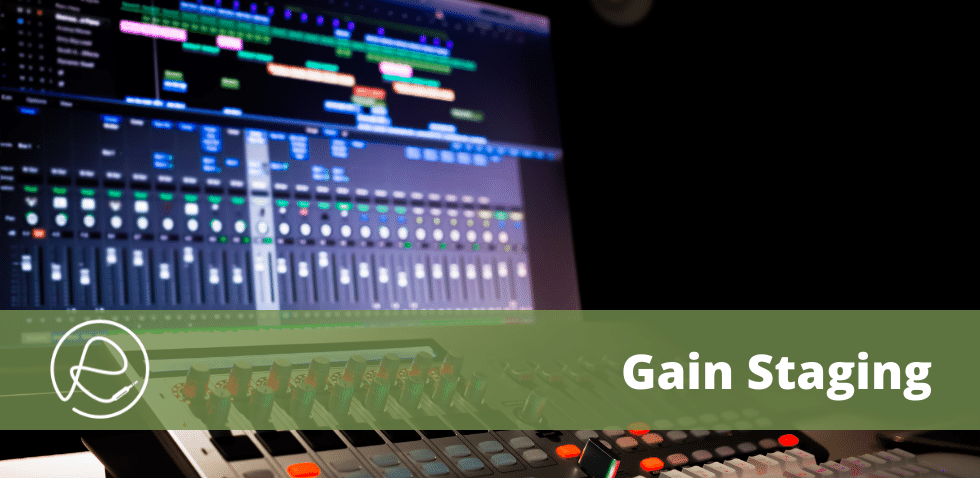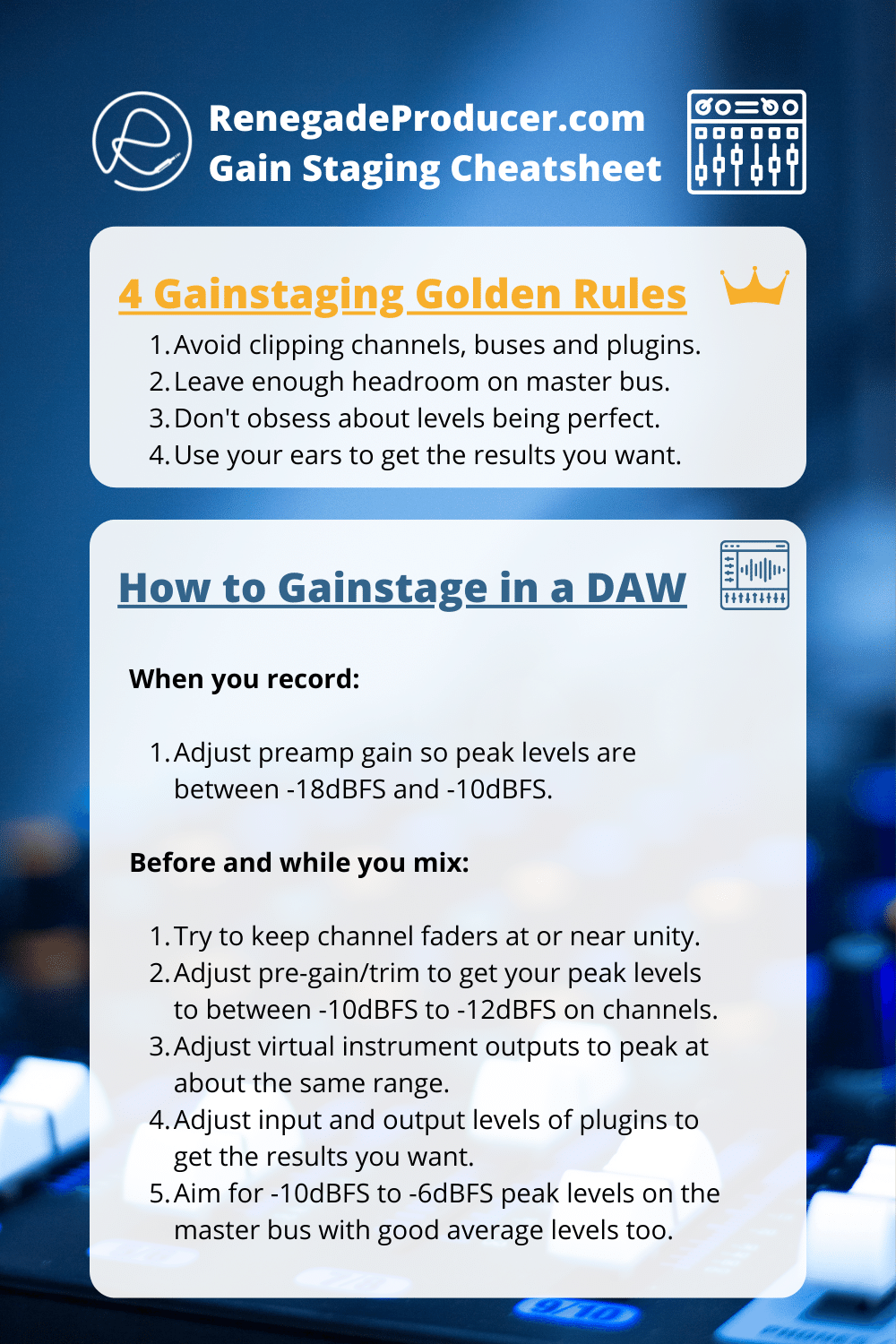25-step music production process checklist and video workshop >>>
Get All Your Gain Staging Questions Answered + Grab a Powerful Cheat Sheet Right Now
What is gain staging? Is it necessary in a DAW? Should you do it after every plugin? What happens if gain is too high? What happens if gain is too low?
Check out any music production or mixing forum or Reddit thread about this topic and you'll soon see that it's very confusing to many aspiring producers and engineers.
It's no wonder. There's a ton of bad advice and so many gurus repeating it that you cannot blame newer producers and engineers if they struggle to make heads or tails of it.
In this post below you'll find a simple way of looking at gain staging and gain structure. You'll also have the most common questions about this topic answered and get access to a gain staging cheat sheet which you can use as a quick reference.

Gain Staging Silliness
Gain staging is important...
... let's just get that out of the way.
That said, it's also made over-complex and overemphasized in many cases.
Advice like "your signal has to hit every plugin in your signal chain at -18dBFS" is just plain wrong.
There's a much simpler way of looking at gain staging and get your gain structure right, without having to be hyper-technical about it.
Gain Staging Simplified
You have a master bus or channel in your DAW. The process of gain staging or getting a good gain structure is simply about how you set your gain levels at every point in your signal chain to get the results you want on your master bus output. This process produces a good mix which then produces a good master.
In other words. get the sound from the first input through all the processors you're using to the final output without distorting or degrading it so you get the sonic results you want.
That's all you really need to know about gain staging and gain structure.
If the above makes sense to you then you can safely stop reading now and get back in the studio.
If the above confuses you in any way then read on so you'll understand all the ins and outs of this topic.
Gain Staging - The Basics
Complete beginners may find the simplified version given above confusing. That's OK.
With a quick overview of the terms and concepts involved you'll quickly start to understand the big picture and never really have to think about gain staging and gain structure ever again.
Let's get it down...
Q: What is Gain?
A: Gain is the increase of signal's amplitude or level by an amplifier.
An amplifier gain knob or fader can therefore be used to either increase or decrease the level of an audio signal that passes through it.
This measurement is usually measured and expressed in various forms of dB.
Q: What is Gain Staging?
A: Gain staging, in live sound, recording, mixing and mastering is the process of adjusting the gain at every point of amplification in your signal chain to make sure you optimize your audio signal.
Q: Should I Gain Stage?
A: Short answer, yes you should.
Should you obsess about it though? No.
Use your ears. If you're getting the results you want on your master bus then you're fine.
Q: What is Bad Gain Staging?
A: Bad gain staging is setting your gain too high or too low at any point in your signal chain which results in either a degraded, distorted or noisy output.
Another mistake is to gain stage in a way that causes your master bus to clip.
Q: What is Good Gain Staging?
A: Good gain staging is setting your gain at the optimum or appropriate level at every point in your audio signal chain and getting the sonic results you want on your final output.
Good results are optimum resolution and enough headroom left for mastering.
Q: How Do You Gain Stage in a DAW?
A: The main goal of gain staging or getting a good gain structure is to make sure you have a healthy signal at every point where your audio signal is amplified. This means you want it at the right level to get the sound you want.
The other important thing is to maintain some headroom on your master bus output.
Every point of amplification in your signal chain is called a gain stage. Adjusting the level on all these gain stages so that they produce the level and sonic results you want on the master bus is what gain staging is all about.

Here's a simple gain staging how to process:
When you record:
- Adjust the pre-amp gain so that your peak levels going into the DAW is between -18dBFS and -10dBFS. The more dynamic the source that you're recording the more you want to err on the safe side and lower your gain or use a compressor to reduce the dynamic range a bit.
In other words, if you have a vocalist that sings very soft in some parts and very loud in other parts then you want to make sure that the loudest parts won't get close to peaking near 0dBFS.
Before and while you mix:
- Leave your channel faders at unity.
- Now adjust your pre-gain/trim to get your peak levels healthy on each channel. -10dBFS to -12dBFS will be fine.
- Adjust your virtual instrument levels in the plugins themselves to get a similar healthy output level.
- Then, as you add insert or send plugins you can adjust the input levels and output levels on each plugin to maintain the same levels. This will differ from plugin to plugin but it's especially important for plugins that change the signal level such as EQs or compressors. If your plugin doesn't have an input or output gain knob or fader you can insert a gain plugin before or after the plugin as needed to match input and output levels.
- Try to adjust everything throughout your mix so that your master bus peaks at around -6dBFS to -10dBFS as this gives the mastering engineer some headroom to work with.
Important: Don't obsess about the numbers. That's a surefire way to waste valuable time while you mix and won't get you better results anyway. Just use your ears. If it sounds good, it is good.
Q: Should You Gain Stage After Every Plugin?
A: The answer is...
... only when needed.
So if the plugin has either boosted or lowered your signal level then you may want to compensate with the output gain of the plugin or by using a separate gain plugin after the plugin in question.
Q: What's the Difference Between Gain and Volume?
A: In simple terms you can think of volume as your output levels and gain as your input levels. This applies to your channels, buses and plugins.
Gain Staging - Conclusion:
Gain staging has become a bit of a hot topic in the audio and music production worlds with so many gurus giving bad advice causing newer producers to obsess over getting "the right" levels and gain structure.
The truth is that there are no "right" levels and there's no need to obey any strict rules when gain staging.
In summary, simply make sure your levels at every stage contribute to the intended results you want on the final output of your master bus. If it sounds good and there's about 6dBFS to 10dBFS of headroom left on the master bus then consider the job done.


Learn to understand equalisers and frequencies to supercharge your mixing skills and get results, fast...

New producer? Learn everything you need to produce your first professional track right now...

Would you like to discover the simplest and easiest way to learn music theory as a music producer?
Share this post. Spread the knowledge so other producers can benefit too:
- Renegade Producer
- Music Production
- Gain Staging
ⓘ Some pages contain affiliate links so I might earn a commission when you buy through my links. Thanks for your support! Learn more

